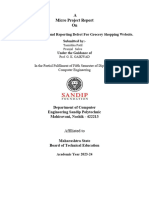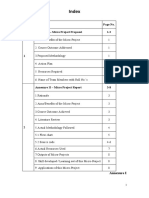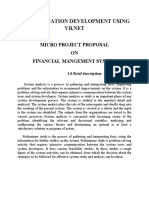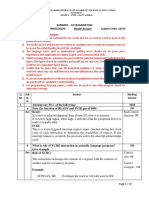Defect Classification: 1.severity Wise 2.work Product Wise 3.type of Error Wise 4.status Wise
Defect Classification: 1.severity Wise 2.work Product Wise 3.type of Error Wise 4.status Wise
Uploaded by
Aditya MhaisaleCopyright:
Available Formats
Defect Classification: 1.severity Wise 2.work Product Wise 3.type of Error Wise 4.status Wise
Defect Classification: 1.severity Wise 2.work Product Wise 3.type of Error Wise 4.status Wise
Uploaded by
Aditya MhaisaleOriginal Description:
Original Title
Copyright
Available Formats
Share this document
Did you find this document useful?
Is this content inappropriate?
Copyright:
Available Formats
Defect Classification: 1.severity Wise 2.work Product Wise 3.type of Error Wise 4.status Wise
Defect Classification: 1.severity Wise 2.work Product Wise 3.type of Error Wise 4.status Wise
Uploaded by
Aditya MhaisaleCopyright:
Available Formats
Unit 4: Defect Management
CO4 : Identify bugs to create defect report of given application.
What is defect?
Defect: A defect is an error or a bug, in the application which is created. A programmer
while designing and building the software can make mistakes or errors. These mistakes or
errors mean that there are flaws in the software. These are called defects.
Defects in any system may arise in various stages of development life cycle. At each stage,
the impact and cost of fixing defects are dependent on various aspects including the defect
arising stage.
Different causes of software defects
Miscommunication of requirements introduces error in code
Unrealistic time schedule for development
Lack of designing experience
Lack of coding practices experience
Human factors introduces errors in code
Lack of version control
Buggy third-party tools
Last minute changes in the requirement introduce error
Poor Software testing skill
Defect Classification
Defect Classification
1.Severity Wise
2.Work Product Wise
3.Type Of Error Wise
4.Status Wise
Course Coordinator : Mrs. Kshirsagar S.R. M.M.Polytechnic , Thergaon Page 1
Unit 4: Defect Management
Severity Wise:
Major: A defect, which will cause an observable product failure or departure from
requirements.
Minor: A defect that will not cause a failure in execution of the product.
Fatal: A defect that will cause the system to crash or close abruptly or effect other
applications.
Work product wise:
SSD: A defect from System Study document
FSD: A defect from Functional Specification document
ADS: A defect from Architectural Design Document
DDS: A defect from Detailed Design document
Source code: A defect from Source code
Test Plan/ Test Cases: A defect from Test Plan/ Test Cases
User Documentation: A defect from User manuals, Operating manuals
Type of Errors Wise:
Comments: Inadequate/ incorrect/ misleading or missing comments in the source
code
Computational Error: Improper computation of the formulae / improper business
validations in code.
Data error: Incorrect data population / update in database
Database Error: Error in the database schema/Design
Missing Design: Design features/approach missed/not documented in the design
document and hence does not correspond to requirements
Inadequate or sub optimal Design: Design features/approach needs additional
inputs for it to be complete Design features described does not provide the best
approach (optimal approach) towards the solution required
In correct Design: Wrong or inaccurate Design
Ambiguous Design: Design feature/approach is not clear to the reviewer. Also
includes ambiguous use of words or unclear design features.
Boundary Conditions Neglected: Boundary conditions not addressed/incorrect
Interface Error: Internal or external to application interfacing error, Incorrect
handling of passing parameters, Incorrect alignment, incorrect/misplaced
fields/objects, un friendly window/screen positions
Logic Error: Missing or Inadequate or irrelevant or ambiguous functionality in
source code
Course Coordinator : Mrs. Kshirsagar S.R. M.M.Polytechnic , Thergaon Page 2
Unit 4: Defect Management
Message Error: Inadequate/ incorrect/ misleading or missing error messages in
source code
Navigation Error: Navigation not coded correctly in source code
Performance Error: An error related to performance/optimality of the code
Missing Requirements: Implicit/Explicit requirements are missed/not documented
during requirement phase
Inadequate Requirements: Requirement needs additional inputs for to be complete
Incorrect Requirements: Wrong or inaccurate requirements
Ambiguous Requirements: Requirement is not clear to the reviewer. Also includes
ambiguous use of words – e.g. Like, such as, may be, could be, might etc.
Sequencing / Timing Error: Error due to incorrect/missing consideration to timeouts
and improper/missing sequencing in source code.
Standards: Standards not followed like improper exception handling, use of E & D
Formats and project related design/requirements/coding standards
System Error: Hardware and Operating System related error, Memory leak
Test Plan / Cases Error: Inadequate/ incorrect/ ambiguous or duplicate or missing -
Test Plan/ Test Cases & Test Scripts, Incorrect/Incomplete test setup
Typographical Error: Spelling / Grammar mistake in documents/source code
Variable Declaration Error: Improper declaration / usage of variables, Type
mismatch error in source code
Status Wise:
Open
Closed
Deferred
Cancelled
Defect Management Process
The process of finding defects and reducing them at the lowest cost is called as Defect
Management Process.
Course Coordinator : Mrs. Kshirsagar S.R. M.M.Polytechnic , Thergaon Page 3
Unit 4: Defect Management
Defect Prevention -- Implementation of techniques, methodology and standard processes to
reduce the risk of defects.
Deliverable Baseline -- Establishment of milestones where deliverables will be considered
complete and ready for further development work. When a deliverable is base lined, any further
changes are controlled. Errors in a deliverable are not considered defects until after the
deliverable is base lined.
Defect Discovery -- Identification and reporting of defects for development team
acknowledgment. A defect is only termed discovered when it has been documented and
acknowledged as a valid defect by the development team member(s) responsible for the
component(s) in error.
Defect Resolution -- Work by the development team to prioritize, schedule and fix a defect, and
document the resolution. This also includes notification back to the tester to ensure that the
resolution is verified.
Process Improvement -- Identification and analysis of the process in which a defect originated
to identify ways to improve the process to prevent future occurrences of similar defects. Also
the validation process that should have identified the defect earlier is analyzed to determine ways
to strengthen that process.
Management Reporting -- Analysis and reporting of defect information to assist management
with risk management, process improvement and project management.
Defect Life Cycle
Course Coordinator : Mrs. Kshirsagar S.R. M.M.Polytechnic , Thergaon Page 4
Unit 4: Defect Management
DEFECT LIFE CYCLE (Bug Life cycle) is the journey of a defect from its identification to
its closure. The Life Cycle varies from organization to organization and is governed by the
software testing process the organization or project follows and/or the Defect tracking tool
being used.
Course Coordinator : Mrs. Kshirsagar S.R. M.M.Polytechnic , Thergaon Page 5
Unit 4: Defect Management
New: When the bug is posted for the first time, its state will be “NEW”. This means
that the bug is not yet approved.
Open: After a tester has posted a bug, the lead of the tester approves that the bug is
genuine and he changes the state as “OPEN”.
Assign: Once the lead changes the state as “OPEN”, he assigns the bug
corresponding developer or developer team. The state of the bug now is changed to
“ASSIGN”.
Test/Retest: Once the developer fixes the bug, he has to assign the bug to the testing
team for next round of testing. Before he releases the software with bug fixed, he
changes the state of bug to “TEST”. It specifies that the bug has been fixed and is
released to testing team.// At this stage the tester do the retesting of the changed code
which developer has given to him to check whether the defect got fixed or not.
Deferred: The bug, changed to deferred state means the bug is expected to be fixed in
next releases. The reasons for changing the bug to this state have many factors. Some
of them are priority of the bug may be low, lack of time for the release or the bug may
not have major effect on the software.
Rejected: If the developer feels that the bug is not genuine, he rejects the bug. Then
the state of the bug is changed to “REJECTED”.
Verified: Once the bug is fixed and the status is changed to “TEST”, the tester tests
the bug. If the bug is not present in the software, he approves that the bug is fixed and
changes the status to “VERIFIED”.
Reopened: If the bug still exists even after the bug is fixed by the developer, the
tester changes the status to “REOPENED”. The bug traverses the life cycle once
again.
Closed: Once the bug is fixed, it is tested by the tester. If the tester feels that the bug
no longer exists in the software, he changes the status of the bug to “CLOSED”. This
state means that the bug is fixed, tested and approved.
Fixed: When developer makes necessary code changes and verifies the changes then
he/she can make bug status as „Fixed‟ and the bug is passed to testing team.
Pending retest: After fixing the defect the developer has given that particular code
for retesting to the tester. Here the testing is pending on the testers end. Hence its
status is pending retest.
Defect Prevention Process
“Prevention is better than cure” applies to defects in the software development life
cycle
Defects, as defined by software developers, are variances from a desired attribute.
These attributes include complete and correct requirements and specifications as
drawn from the desires of potential customers.
Course Coordinator : Mrs. Kshirsagar S.R. M.M.Polytechnic , Thergaon Page 6
Unit 4: Defect Management
Thus, defects cause software to fail to meet requirements and make customers
unhappy.
when a defect gets through during the development process, the earlier it is
diagnosed, the easier and cheaper is the rectification of the defect.
The end result in prevention or early detection is a product with zero or minimal
defects.
Identify Critical Risks -- Identify the critical risks facing the project or system. These are the
types of defects that could jeopardize the successful construction, delivery and/or operation of
the system.
Estimate Expected Impact -- For each critical risk, make an assessment of the financial impact
if the risk becomes a problem.
Minimize Expected Impact -- Once the most important risks are identified try to eliminate
each risk. For risks that cannot be eliminated, reduce the probability that the risk will become a
problem and the financial impact should that happen.
The five general activities of defect prevention are:
1. Software Requirements Analysis
Defects introduced during the requirements and design phase are not only more probable
but also are more severe and more difficult to remove.
Front-end errors in requirements and design cannot be found and removed via testing, but
instead need pre-test reviews and inspections.
2. Reviews: Self-Review and Peer Review
Self-review is one of the most effective activity in uncovering the defects which may later be
discovered by a testing team or directly by a customer.
A self-review of the code helps reduce the defects related to algorithm mplementations,
incorrect logic or certain missing conditions.
Course Coordinator : Mrs. Kshirsagar S.R. M.M.Polytechnic , Thergaon Page 7
Unit 4: Defect Management
Peer review is similar to self-review in terms of the objective – the only difference is that it
is a peer (someone who understands the functionality of the code very well) who reviews the
code
3. Defect Logging and Documentation
Effective defect tracking begins with a systematic process. A structured tracking process
begins with initially logging the defects, investigating the defects, then providing the structure to
resolve them. Defect analysis and reporting offer a powerful means to manage defects and defect
depletion trends, hence, costs.
Root Cause Analysis and Preventive Measures Determination
After defects are logged and documented, the next step is to analyze them
Reducing the defects to improve the quality: The analysis should lead to implementing
changes in processes that help prevent defects and ensure their early detection.
Applying local expertise: The people who really understand what went wrong are the people
present when the defects were inserted – members of the software engineering team. They can
give the best suggestions for how to avoid such defects in the future.
Targeting the systematic errors: There may be many errors or defects to be handled in such
an analysis forum; however, some mistakes tend to be repeated. These systematic errors account
for a large portion of the defects found in the typical software project.
5. Embedding Procedures into Software Development Process
Implementation is the toughest of all activities of defect prevention.
It requires total commitment from the development team and management.
A plan of action is made for deployment of the modification of the existing processes or
introduction of the new ones with the consent of management and the team.
Defect Report Template
A defect report documents an anomaly discovered during testing.
It includes all the information needed to reproduce the problem, including the author,
release/build number, open/close dates, problem area, problem description, test
environment, defect type, how it was detected, who detected it, priority, severity,
status, etc. After uncovering a defect (bug), testers generate a formal defect report.
The purpose of a defect report is to state the problem as clearly as possible so that
developers can replicate the defect easily and fix it.
Course Coordinator : Mrs. Kshirsagar S.R. M.M.Polytechnic , Thergaon Page 8
Unit 4: Defect Management
Estimate Expected Impact Of A Defect
Defect Impact: The degree of severity that a defect has on the development or operation
of a component or system.
How to Estimate the defect impact
1. Once the critical risks are identified, the financial impact of each risk should be
estimated.
2. This can be done by assessing the impact, in dollars, if the risk does become a problem
combined with the probability that the risk will become a problem.
3. The product of these two numbers is the expected impact of the risk.
Course Coordinator : Mrs. Kshirsagar S.R. M.M.Polytechnic , Thergaon Page 9
Unit 4: Defect Management
4. The expected impact of a risk (E) is calculated as
E = P * I, where:
P= probability of the risk becoming a problem and
I= Impact in dollars if the risk becomes a problem.
Once the expected impact of each risk is identified, the risks should be prioritized by the
expected impact and the degree to which the expected impact can be reduced. While guess work
will constitute a major role in producing these numbers, precision is not important. What will be
important is to identify the risk, and determine the risk's order of magnitude. Large, complex
systems will have many critical risks. Whatever can be done to reduce the probability of each
individual critical risk becoming a problem to a very small number should be done. Doing this
increases the probability of a successful project by increasing the probability that none of the
critical risks will become a problem.
One should assume that an individual critical risk has a low probability of becoming a problem
only when there is specific knowledge justifying why it is low. For example, the likelihood that
an important requirement was missed may be high if developers have not involved users in the
project. If users have actively participated in the requirements definition, and the new system is
not a radical departure from an existing system or process, the likelihood may be low.
For example:
o An organization with a project of 2,500 function points and was about medium at defect
discovery and removal would have 1,650 defects remaining after all defect removal and
discovery activities.
o The calculation is 2,500 x 1.2 = 3,000 potential defects.
o The organization would be able to remove about 45% of the defects or 1,350 defects.
o The total potential defects (3,000) less the removed defects (1,350) equals the remaining
defects of 1,650.
Techniques For Finding Defects
Defects are found either by preplanned activities specifically intended to uncover defects
(e.g., quality control activities such as inspections, testing, etc.) or by accident (e.g., users
in production).
Techniques to find defects can be divided into three categories:
Static techniques: Testing that is done without physically executing a program or
system. A code review is an example of a static testing technique.
Course Coordinator : Mrs. Kshirsagar S.R. M.M.Polytechnic , Thergaon Page 10
Unit 4: Defect Management
Dynamic techniques: Testing in which system components are physically executed to
identify defects. Execution of test cases is an example of a dynamic testing technique.
Operational techniques: An operational system produces a deliverable containing a
defect found by users, customers, or control personnel -- i.e., the defect is found as a
result of a failure.
While it is beyond the scope of this study to compare and contrast the various static,
dynamic, and operational techniques, the research did arrive at the following conclusions:
Both static and dynamic techniques are required for an effective defect management
program. In each category, the more formally the techniques were integrated into the
development process, the more effective they were.
Since static techniques will generally find defects earlier in the process, they are more
efficient at finding defects.
Reporting a Defect
Be specific:
1. Specify the exact action: Do not say something like ‘Select ButtonB’. Do you
mean ‘Click ButtonB’ or ‘Press ALT+B’ or ‘Focus on ButtonB and click
ENTER’? Of course, if the defect can be arrived at by using all the three ways,
it’s okay to use a generic term as ‘Select’ but bear in mind that you might just get
the fix for the ‘Click ButtonB’ scenario. [Note: This might be a highly unlikely
example but it is hoped that the message is clear.]
2. In case of multiple paths, mention the exact path you followed: Do not say
something like “If you do ‘A and X’ or ‘B and Y’ or ‘C and Z’, you get D.”
Understanding all the paths at once will be difficult. Instead, say “Do ‘A and X’
and you get D.” You can, of course, mention elsewhere in the report that “D can
also be got if you do ‘B and Y’ or ‘C and Z’.”
3. Do not use vague pronouns: Do not say something like “In ApplicationA, open X,
Y, and Z, and then close it.” What does the ‘it’ stand for? ‘Z’ or, ‘Y’, or ‘X’ or
‘ApplicationA’?”
Be detailed:
1. Provide more information (not less). In other words, do not be lazy. Developers
may or may not use all the information you provide but they sure do not want to
beg you for any information you have missed.
Be objective:
1. Do not make subjective statements like “This is a lousy application” or “You
fixed it real bad.”
Course Coordinator : Mrs. Kshirsagar S.R. M.M.Polytechnic , Thergaon Page 11
Unit 4: Defect Management
2. Stick to the facts and avoid the emotions.
Reproduce the defect:
1. Do not be impatient and file a defect report as soon as you uncover a defect.
Replicate it at least once more to be sure. (If you cannot replicate it again, try
recalling the exact test condition and keep trying. However, if you cannot
replicate it again after many trials, finally submit the report for further
investigation, stating that you are unable to reproduce the defect anymore and
providing any evidence of the defect if you had gathered. )
Review the report:
1. Do not hit ‘Submit’ as soon as you write the report. Review it at least once.
Remove any typos.
Course Coordinator : Mrs. Kshirsagar S.R. M.M.Polytechnic , Thergaon Page 12
You might also like
- MicroprojectDocument18 pagesMicroprojectDilip ShivdikarNo ratings yet
- ServiceNow Knowledge Sources 2022-11-01Document250 pagesServiceNow Knowledge Sources 2022-11-01Rahim shaikh100% (1)
- "Software Testing On Flipkart E-Commerce Website: Diploma in Computer EngineeringDocument4 pages"Software Testing On Flipkart E-Commerce Website: Diploma in Computer EngineeringAshutosh Patil0% (1)
- Model Answer: Important Instructions To ExaminersDocument33 pagesModel Answer: Important Instructions To ExaminersPratiksha KatapNo ratings yet
- Defect Report 1Document2 pagesDefect Report 1khatibfaizan55No ratings yet
- Css 22519 Lab ManualDocument48 pagesCss 22519 Lab ManualShivkanya Awate DipaliNo ratings yet
- ACN MicroprojectDocument16 pagesACN MicroprojectAditya GhuleNo ratings yet
- STE Micro Project-1Document14 pagesSTE Micro Project-1dnyaneshwar kapseNo ratings yet
- Amar K Project-2Document17 pagesAmar K Project-2AMAR KHARAT100% (1)
- VIMP CSS Board Qus V2VDocument146 pagesVIMP CSS Board Qus V2Vgauravchoure37No ratings yet
- Osy NotesDocument13 pagesOsy Notespankaj waghmareNo ratings yet
- Est 22447 Environmental Studies Msbte MicroprojectDocument2 pagesEst 22447 Environmental Studies Msbte Microprojectshubhambhagwat2022No ratings yet
- Grocery Store Microproject (22518)Document25 pagesGrocery Store Microproject (22518)Tanishka PatilNo ratings yet
- Zeal Polytechnic: Micro ProjectDocument14 pagesZeal Polytechnic: Micro ProjectAbhishek ShelarNo ratings yet
- Microprocessor Project Completed 4th SemDocument21 pagesMicroprocessor Project Completed 4th SemRahul100% (1)
- Defect Report Flipkart ApplicationDocument2 pagesDefect Report Flipkart Applicationomkargadhave905No ratings yet
- EDE Practical No. 15Document2 pagesEDE Practical No. 15Fiza PathanNo ratings yet
- 17512-2019-Winter-Model-Answer-Paper (Msbte Study Resources)Document36 pages17512-2019-Winter-Model-Answer-Paper (Msbte Study Resources)Aditya BorleNo ratings yet
- MIC MicroprojectDocument11 pagesMIC Microprojectgirish desaiNo ratings yet
- Ste 22518 Oral NotesDocument16 pagesSte 22518 Oral NotesTejaswini MahajanNo ratings yet
- OSY Summer 23Document25 pagesOSY Summer 23706:Pranav BhingareNo ratings yet
- STE Pra 14Document1 pageSTE Pra 14gmpawar003No ratings yet
- Mic Report G2Document5 pagesMic Report G2Prathmesh GalheNo ratings yet
- STE Pra 13 NewDocument2 pagesSTE Pra 13 Newgmpawar003No ratings yet
- AJP Micro-Project Report - SurajDocument23 pagesAJP Micro-Project Report - SurajMorris jonsonNo ratings yet
- Sen Final MPDocument27 pagesSen Final MPsampada varadkarNo ratings yet
- OSY MicroprojectDocument10 pagesOSY MicroprojectIF19Pratik ShingadeNo ratings yet
- Project Report: Evelop A Small Animation Using Applet Graphics and MultithreadingDocument10 pagesProject Report: Evelop A Small Animation Using Applet Graphics and MultithreadingGrove VlogsNo ratings yet
- OSY Lecture 2 Notes - MSBTE NEXT ICONDocument11 pagesOSY Lecture 2 Notes - MSBTE NEXT ICONBarik PradeepNo ratings yet
- Title: Organizational Structure of Sumago Infotech and General LayoutDocument15 pagesTitle: Organizational Structure of Sumago Infotech and General Layoutkomal ghodke100% (1)
- Osy Microproject ReportDocument13 pagesOsy Microproject ReportHarish chafakarandeNo ratings yet
- GUI Micro ProjectDocument19 pagesGUI Micro ProjectSatyajit DeshmukhNo ratings yet
- Hubs & SwitchesDocument5 pagesHubs & Switchesrude dcostaNo ratings yet
- Micro Project Report: (Your Guide Name)Document11 pagesMicro Project Report: (Your Guide Name)jaya bhutekarNo ratings yet
- OSYDocument25 pagesOSYMISBAH NAIKNo ratings yet
- STE_S24Document25 pagesSTE_S24sakshi1482005No ratings yet
- OSY-Microproject V VDocument20 pagesOSY-Microproject V VComputer ActivityNo ratings yet
- OSY Micropoject (Group F)Document15 pagesOSY Micropoject (Group F)Rutuja IngaleNo ratings yet
- Oop Winter 2019 (C++)Document21 pagesOop Winter 2019 (C++)Aditya BorleNo ratings yet
- GAD Full ManualDocument173 pagesGAD Full ManualSahil Surve100% (2)
- Index: Sr. No. Page No. Annexure I - Micro Project Proposal 1-2Document11 pagesIndex: Sr. No. Page No. Annexure I - Micro Project Proposal 1-2Avadhut DeshmukhNo ratings yet
- STE Software Testing 22518 Micro Project 5th Semester MSBTEDocument8 pagesSTE Software Testing 22518 Micro Project 5th Semester MSBTEtom444842No ratings yet
- OPS-Chapter-2-Services and Components of Operating SystemsDocument10 pagesOPS-Chapter-2-Services and Components of Operating Systemsom jageNo ratings yet
- Mobile Application Development Pratical2Document4 pagesMobile Application Development Pratical2Nishant KadamNo ratings yet
- Title OF Micro ProjectDocument19 pagesTitle OF Micro ProjectRahulNo ratings yet
- Client Side Scripting Micro Project IdeasDocument2 pagesClient Side Scripting Micro Project IdeasDhanshree Gaikwad100% (1)
- Osy Meena Chapter-5Document11 pagesOsy Meena Chapter-5tendulkarnishchalNo ratings yet
- Ajp ProjectDocument4 pagesAjp ProjectMISBAH NAIK0% (1)
- Microproject FormatDocument8 pagesMicroproject FormatTAJKAZINo ratings yet
- Test Cases by DhirajDocument50 pagesTest Cases by DhirajRambo GamingNo ratings yet
- Microproject AjpDocument19 pagesMicroproject AjpGopal ChincholeNo ratings yet
- GUI MicroprojectDocument58 pagesGUI Microprojectgirish desaiNo ratings yet
- Css Manual PDFDocument137 pagesCss Manual PDFTejas NiphadeNo ratings yet
- Aim: Write A Program To Demonstrate The Use of AWT Components. X. Program CodeDocument9 pagesAim: Write A Program To Demonstrate The Use of AWT Components. X. Program CodeSiddhi SawantNo ratings yet
- Department of Computer Engineering: Develop A Webpage For Validation of Form Fields Using Regular ExpressionsDocument3 pagesDepartment of Computer Engineering: Develop A Webpage For Validation of Form Fields Using Regular ExpressionsShekhar JadhavNo ratings yet
- STE UNIT-5 NotesDocument14 pagesSTE UNIT-5 Notessachingunjal401No ratings yet
- Design Test Cases For Fingerprint Voting System": A Micro Project OnDocument15 pagesDesign Test Cases For Fingerprint Voting System": A Micro Project OnPratham Bhosale100% (1)
- AJP - QB SolvedDocument20 pagesAJP - QB Solved40Neha PagariyaNo ratings yet
- GAD MicroprojectDocument15 pagesGAD MicroprojectJameer InamdarNo ratings yet
- Unit 4 Defect ManagementDocument13 pagesUnit 4 Defect ManagementPankaj SangaleNo ratings yet
- Defect ManagementDocument30 pagesDefect ManagementAawes AnsariNo ratings yet
- CO5: Test Software For Performance Measure Using Automation Testing ToolsDocument9 pagesCO5: Test Software For Performance Measure Using Automation Testing ToolsAditya MhaisaleNo ratings yet
- CO3: Prepare Test Plan For An ApplicationDocument12 pagesCO3: Prepare Test Plan For An ApplicationAditya MhaisaleNo ratings yet
- Man Made DisastersDocument11 pagesMan Made DisastersAditya MhaisaleNo ratings yet
- EVS - Assessments - CO1 - All UOsDocument13 pagesEVS - Assessments - CO1 - All UOsAditya Mhaisale100% (1)
- FiveSemester CO CM CW PDFDocument73 pagesFiveSemester CO CM CW PDFAditya MhaisaleNo ratings yet
- Program - CIVIL Engineering Program Code - CE Msbtes E-ContentDocument16 pagesProgram - CIVIL Engineering Program Code - CE Msbtes E-ContentAditya MhaisaleNo ratings yet
- EVS - PPT - UO 1eDocument14 pagesEVS - PPT - UO 1eAditya MhaisaleNo ratings yet
- EVS - PPT - UO 1d 1eDocument20 pagesEVS - PPT - UO 1d 1eAditya MhaisaleNo ratings yet
- N 1Document5 pagesN 1Aditya MhaisaleNo ratings yet
- Msbtes E-Content: Program - Civil Engineering Program Code - Ce Course-Environmental Studies Course Code - 22447Document21 pagesMsbtes E-Content: Program - Civil Engineering Program Code - Ce Course-Environmental Studies Course Code - 22447Aditya Mhaisale100% (1)
- Nili CDocument5 pagesNili CAditya MhaisaleNo ratings yet
- 22415-2019-Winter-Model-Answer-Paper (Msbte Study Resources)Document23 pages22415-2019-Winter-Model-Answer-Paper (Msbte Study Resources)Aditya MhaisaleNo ratings yet
- Topics of DiscussionDocument22 pagesTopics of DiscussionAditya MhaisaleNo ratings yet
- Rollno:-18366: 1 Define EnvironmentDocument9 pagesRollno:-18366: 1 Define EnvironmentAditya MhaisaleNo ratings yet
- Test Case ID Test Case Objectiv e Prerequisite S Steps Input Data Expecte D Result Actual Result StatusDocument3 pagesTest Case ID Test Case Objectiv e Prerequisite S Steps Input Data Expecte D Result Actual Result StatusAditya MhaisaleNo ratings yet
- BarcodeDocument31 pagesBarcodeSarthak JainNo ratings yet
- 1106 - Iot 002 - Iot 0776Document14 pages1106 - Iot 002 - Iot 07760000rcnNo ratings yet
- Yuk Berhijab Felix y Siauw PDFDocument2 pagesYuk Berhijab Felix y Siauw PDFAndrytany ClluNo ratings yet
- Using The SQL Transformation in An Informatica Developer MappingDocument10 pagesUsing The SQL Transformation in An Informatica Developer MappingShannonNo ratings yet
- Install and Upgrade Cisco Unified CME SoftwareDocument20 pagesInstall and Upgrade Cisco Unified CME SoftwareChristian RodríguezNo ratings yet
- Solved - Cursor Freeze When Cross Borders - Autodesk Community - AutoCADDocument7 pagesSolved - Cursor Freeze When Cross Borders - Autodesk Community - AutoCADErick EnriquezNo ratings yet
- Ow360 30Document310 pagesOw360 30kumarNo ratings yet
- 1.launch The Below URL's in Firefox BrowserDocument6 pages1.launch The Below URL's in Firefox BrowserRani raniNo ratings yet
- Sap Standard BPMLDocument14 pagesSap Standard BPMLAarna SharmaNo ratings yet
- Postdoc2 Irc-Mar PDFDocument2 pagesPostdoc2 Irc-Mar PDFMuhammad AhmadNo ratings yet
- Mango User ManualDocument5 pagesMango User ManualJonaNo ratings yet
- Analysis of Synchronization Mechanisms in Operating SystemsDocument19 pagesAnalysis of Synchronization Mechanisms in Operating Systemsijcijournal1821No ratings yet
- THOMAS A MIRAGLIA (347) 216-9725 410 Windwalker DR, St. Augustine FL 32092Document3 pagesTHOMAS A MIRAGLIA (347) 216-9725 410 Windwalker DR, St. Augustine FL 32092Thomas MiragliaNo ratings yet
- Day 4Document24 pagesDay 4Arolf PatacsilNo ratings yet
- Chapter 28: Advanced Relational Database DesignDocument16 pagesChapter 28: Advanced Relational Database DesignHermawan HermawanNo ratings yet
- Zebra ZD500 Printer Specifications: Standard FeaturesDocument4 pagesZebra ZD500 Printer Specifications: Standard FeaturesToko Cinta SunnahNo ratings yet
- Naan Mudhalvan Project Phase1Document2 pagesNaan Mudhalvan Project Phase1malarkodignanavelu2005No ratings yet
- Classification of Software Projects: Prof. Dr. M. A. Pasha Rector IT-hub SargodhaDocument17 pagesClassification of Software Projects: Prof. Dr. M. A. Pasha Rector IT-hub SargodhaRadwan AhmedNo ratings yet
- (HD) Chapter 11 Human Technology Interface OrlandoDocument43 pages(HD) Chapter 11 Human Technology Interface Orlandocabalidalyn08No ratings yet
- CNS by MUSADocument1 pageCNS by MUSAParth VoraNo ratings yet
- Serial and Direct Data AccessDocument3 pagesSerial and Direct Data AccessTemp TempNo ratings yet
- Assignment MES3043Document40 pagesAssignment MES3043somerandomhedgehogNo ratings yet
- Short Description VibExcelReportDocument5 pagesShort Description VibExcelReportgoksel OnverNo ratings yet
- DDMS Part-1Document35 pagesDDMS Part-1nahidul alamNo ratings yet
- JBoss Drools IntroductionDocument196 pagesJBoss Drools Introductiondarksoulg7No ratings yet
- Shashank Mishra DE 3YoEDocument1 pageShashank Mishra DE 3YoEGorre RohithNo ratings yet
- Simple Knife Sharpener For Stones or Sandpaper by Rlasse - Download Free STL ModelDocument3 pagesSimple Knife Sharpener For Stones or Sandpaper by Rlasse - Download Free STL ModelAnton OlivNo ratings yet
- Imagicle AppSuite Cross Platform - Advanced Configuration - High AvailabilityDocument30 pagesImagicle AppSuite Cross Platform - Advanced Configuration - High AvailabilitylikesmileljkeeNo ratings yet
- MIC NotesDocument17 pagesMIC Notesjhalodwalaaliasgar53No ratings yet








































































































